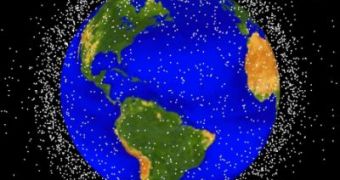Twelve space vehicles carrying 200 giants nets each, could remove orbiting space junk and make way for a future space elevator, scientists from Star Inc., a company that is receiving funding for the project from DARPA, stated last Friday at the annual Space Elevator conference.
DARPA is the research and development program for the United States Department of Defense, and its mission is to maintain technological superiority of the US military as well as keeping an eye on other countries' technological advancements.
Star Incorporated plans to start test flights in 2013 and if everything goes according to plan, it could begin removing space junk in 2017.
In order to dismiss any concern that the Electrodynamic Debris Eliminator vehicles might be used for military purposes and remove enemy satellites from orbit, the company is shifting the project from DARPA to NASA and possibly to the UN, later.
Jerome Pearson, the president of Star Inc. was one of the first believers in space elevators, as in 1975 he wrote a paper that inspired Arthur C. Clarke’s description of a space elevator in his SF book “The Fountains of Paradise”.
The space elevator basically consists of a long cable of nanomaterials that stretches from Earth to a point in geostationary orbit, around 22,000 miles above the surface, and its mission is to carry people and objects into space on its shuttles.
Before building such an impressive device, all space debris should be removed as they are a real threat to the elevator's cables, like former NASA scientist Ivan Bekey suggested at the conference, two years ago.
Around the Earth are currently floating 2,465 identified objects over two kilograms, like broken satellites, fragments of rockets, and any unused object originally built and launched by humans, that is no longer used.
Pearson said that within seven years, a dozen of Star Inc.'s EDDE vehicles could capture Earth-orbiting objects and either fling them into the South Pacific, send them closer to Earth where they would eventually fall or recycle the materials.
He added that for the 12 spacecrafts to operate safely, without colliding into each other, a form of space traffic control is necessary, Physorg relates.

 14 DAY TRIAL //
14 DAY TRIAL //